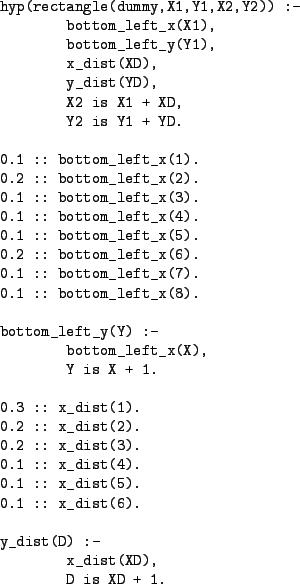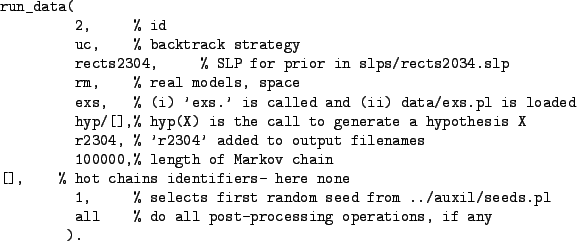In the previous section there were only six hypotheses, so the use of
MCMC was entirely unnecessary, except for tutorial purposes. In this
section we start to move towards more realistic examples.
Fig 11 shows an alternative prior over a hypothesis
space of
![]() rectangles. Rectangles
are sampled from this prior by first choosing the
rectangles. Rectangles
are sampled from this prior by first choosing the ![]() and
and ![]() values
for the bottom left corner of the rectangle, and then choosing the
horizontal and vertical lengths of the rectangle. The definitions of
x_dist/1 and y_dist/1 give a bias towards smaller
rectangles. The definitions of bottom_left_x/1 and
bottom_right_x/1 mean that
values
for the bottom left corner of the rectangle, and then choosing the
horizontal and vertical lengths of the rectangle. The definitions of
x_dist/1 and y_dist/1 give a bias towards smaller
rectangles. The definitions of bottom_left_x/1 and
bottom_right_x/1 mean that ![]() and
and ![]() are a
priori the most probable locations for the bottom left-hand corner.
Note that now all rectangles get the same name: dummy. We
keep this dummy argument in our representation of hypotheses to save
us the bother of re-writing the likelihood functions. The code
displayed in Fig 11 can be found in
tutorial/slps/rects2304.slp.
are a
priori the most probable locations for the bottom left-hand corner.
Note that now all rectangles get the same name: dummy. We
keep this dummy argument in our representation of hypotheses to save
us the bother of re-writing the likelihood functions. The code
displayed in Fig 11 can be found in
tutorial/slps/rects2304.slp.
 |
To use this new prior it suffices to have an appropriate run_data/11fact in the runs file. Fig 12 shows the relevant fact which can be found in tutorial/runs/concept_learning_run.pl. This is identical to the run_data/11fact shown in Fig 7, except that it points to a different file for locating the SLP prior (and uses a different id and output filename string).
 |
Doing:
zcat tr_uc_rm_exs_r2304_i100K__s1.gz | grep '^c' | sort | uniq -c | sort -rn
where tr_uc_rm_exs_r2304_i100K__s1.gz is the
output file, gives us the frequency with which each rectangle was
visited. Fig 13 shows that the most frequently visited
rectangles (and hence those with highest estimated posterior
probability) are as expected. They are consistent with the data
and had high prior probability. However, the least visited rectangle
rectangle(dummy,6,4,8,7) is not consistent with the data so
it might seem odd that it was visited at all--after all it was
visited 29 times which leads to an estimated posterior probability of
![]() rather than the correct value of 0. What has happened is
that, by chance,
rectangle(dummy,6,4,8,7) is the initial model. For the first
28 iterations another inconsistent model was proposed, and the proposal
is rejected. On the 29th iteration rectangle(dummy,3,4,9,8),
a consistent rectangle, is eventually proposed. From that point on the
chain visits only consistent models. Again, this shows the importance
of discarding (for real applications) an initial `burn-in' part of the
sample.
rather than the correct value of 0. What has happened is
that, by chance,
rectangle(dummy,6,4,8,7) is the initial model. For the first
28 iterations another inconsistent model was proposed, and the proposal
is rejected. On the 29th iteration rectangle(dummy,3,4,9,8),
a consistent rectangle, is eventually proposed. From that point on the
chain visits only consistent models. Again, this shows the importance
of discarding (for real applications) an initial `burn-in' part of the
sample.